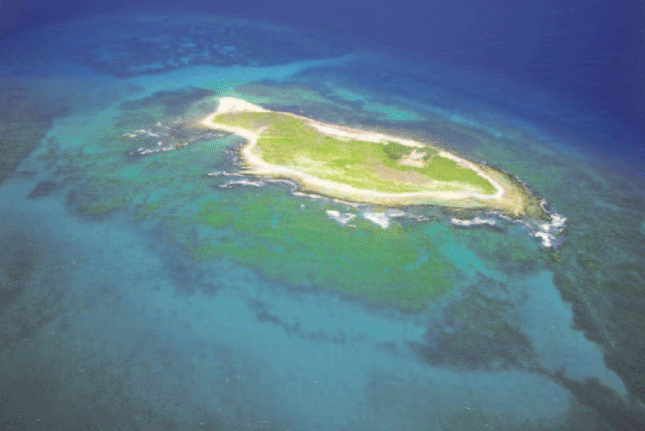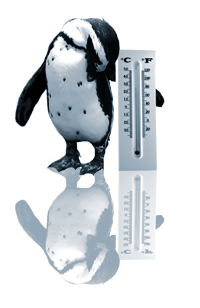Climántica :: Biblioteca
- Galego
- |
- Castellano
- |
- English
Water temperature rise
The ocean also gets warm, by about 0.04 degrees Celsius per decade. This is a general trend but at a local level these trends can change. Thus, in the province of A Coruña observations indicate that this trend is less clear than in the Cantabrian area.
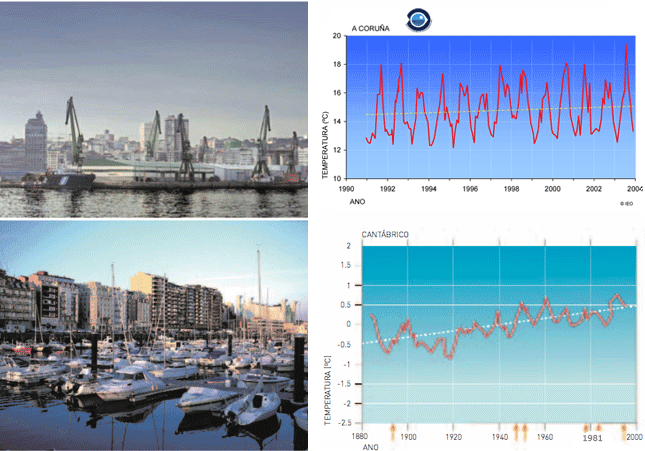

As a consequence of this warming, ice on the Poles is gradually melting, leading to a sea level rise. Historical records show that the sea level has risen about 1-2 mm/year over the 20th century. At the same time this increase varies according to the different coastal areas. For example, Galician coasts have gone through a sea level rise of 2-3 mm/year over the second half of the 20th century. This means that during the last century it has risen 10-20 cm, and by 2100 a rise of 9-88 cm is considered possible. But this sea level rise is not only attributable to ice melting but also to water expansion due to warming.
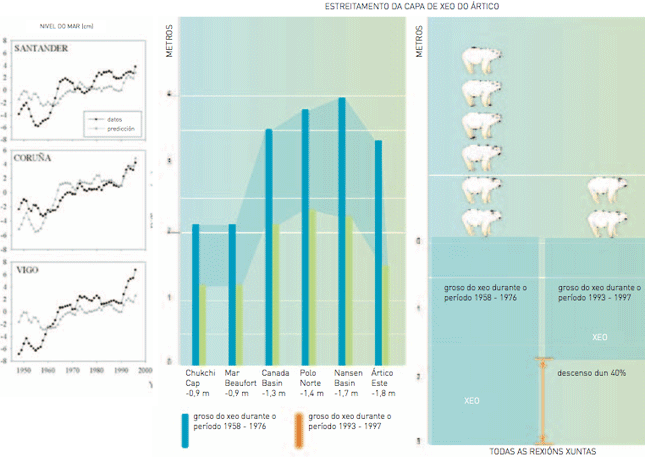
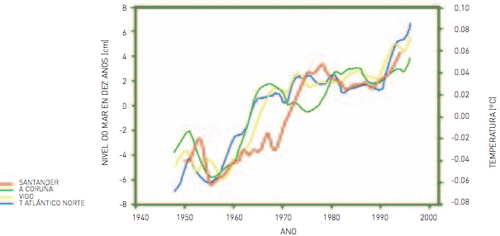
Effects of the freshwater influx into sea due to ice melting
Although observations confirm that the ocean’s global temperature has increased in some areas there is evidence of temperature decrease. Thus, the North Atlantic has become significantly cooler and the degree of salinity has been reduced in 1885-1999 at the same time as the global temperature is rising.
This event can be understood as an effect of the influx of melt water from the Greenland ice sheet and therefore, making water less salty and less dense. As a consequence, surface warm water masses float over denser ones, but this depends on the salinity provided by dissolved salts. Therefore, climate conditions whose thermal regulation depends on these circulation currents can be affected, since warm surface water cannot flow downwards into the depths in order to become colder.
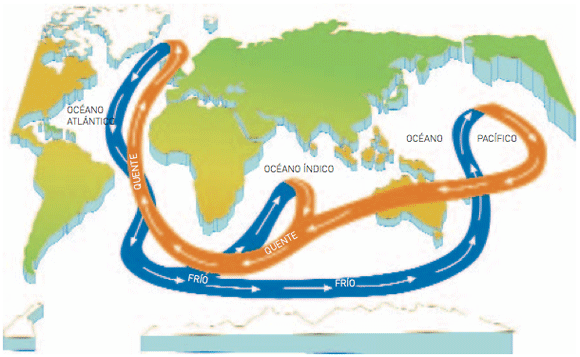
The nearest drastic effects due to interferences into this current took place at the end of the last ice age, when the biggest ice sheets started retreating towards the Polar regions. As the Earth’s global temperature increased at the end of the last ice age, 10 800 years ago, a sudden climatic change took place in Europe, giving rise to a strong decrease in temperature. It seems that it was caused by the influx of melting water from the North Atlantic, most of which came from the disappeared Agassiz Lake
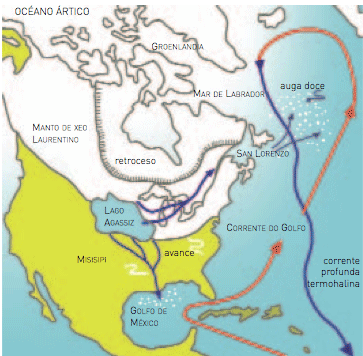
Although these effects do not take place today, it is clear that more and more freshwater is being introduced into the North Atlantic, changing the Gulf Stream and the ocean’s stream circulation.
Effects on marine species
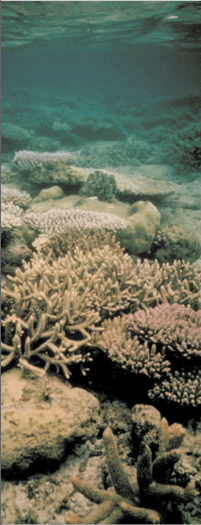 Global warming has impacts on marine ecosystems derived from the rise in global temperature, such as coral bleaching and migration of species.
Global warming has impacts on marine ecosystems derived from the rise in global temperature, such as coral bleaching and migration of species.
Coral bleaching can damage very seriously or even destroy coral reef colonies. The corals that form the structure of the great reef ecosystems depend on microscopic algae called zooxanthellae that feed and give coral its particular coloration. Under stress, corals may expel their zooxantheallae, which leads to a lighter or completely white appearance, hence the term "bleached". If the zooxanthellae clade is not restored, coral is killed.
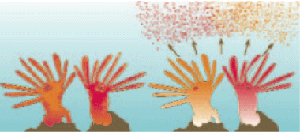 If temperature rises only 1 degree Celsius over the summer temperature in shallow areas where coral lives, it can undergo bleaching. Tropical waters, where the world’s biggest coral reefs are found, have gone through such temperature rise over the last 100 years. The Great Barrier Reef along the Australia’s Northeastern coast suffered a mass coral bleaching event in 2002, with over 60% of corals killed.
If temperature rises only 1 degree Celsius over the summer temperature in shallow areas where coral lives, it can undergo bleaching. Tropical waters, where the world’s biggest coral reefs are found, have gone through such temperature rise over the last 100 years. The Great Barrier Reef along the Australia’s Northeastern coast suffered a mass coral bleaching event in 2002, with over 60% of corals killed.
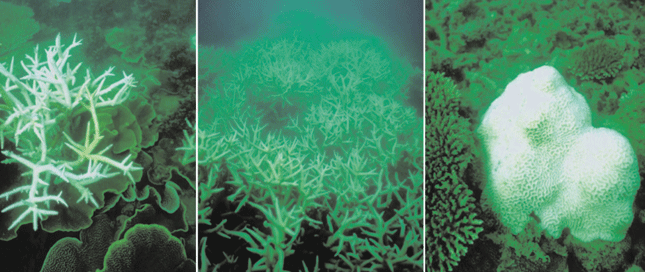
Many organisms respond to climate change conditioned by water temperature rise traveling towards waters with temperatures where they are better adapted. Many thermal expansions are known in different species.
The species that are fixed to the substrate, such as the big brown algae Sacchorrhiza polyschides, are those that mainly suffer this migration process.
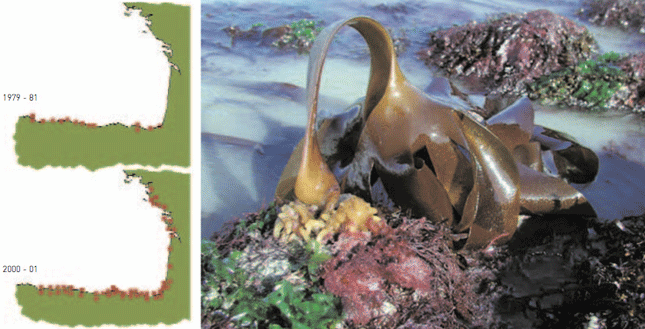
Effects of the increasing dissolved carbon dioxide
Climate change’s impacts on marine environment include acidification caused by carbon dioxide dissolved in sea water.
As it was said in the chapter on the carbon cycle, the sea environment is very efficient in carbon sequestration since phytoplankton removes carbon dioxide via photosynthesis by means of the food chain, and it is finally deposited in the shell sediments introduced in the sedimentary rocks and the oil fossil carbon chains.
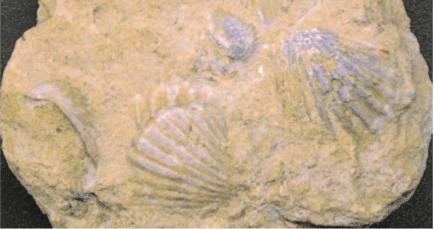
Nevertheless, oceans are nowadays an enormous carbon dioxide sink caused by human activity. Recent research reveals that over the last 200 years oceans have absorbed almost half of the CO2 released into the atmosphere by human activity.
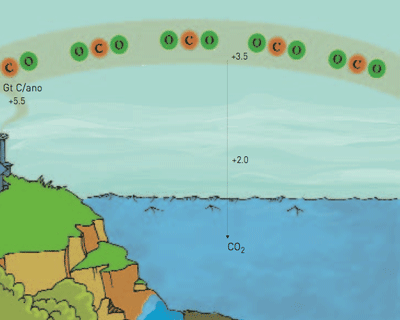
By means of the absorption process oceans helped to mitigate climate change. Nevertheless those sequestration mechanisms cannot take the carbon dioxide released by human activity into the Earth and, therefore, it is quickly released into the atmosphere in fossil fuel combustion processes.
Carbon dioxide is found on the oceans’ surface and it can be identified by the carbon isotope present in fossil fuels. In the Atlantic Ocean it can be introduced more easily due to the degree of waving.

Increasing CO2 concentrations on the ocean surface are changing the sea’s chemistry, causing water acidification by means of carbon dioxide reaction with water. Scientific research indicates that this change in the ocean’s chemistry could have a devastating impact on corals, shellfish, specific groups of phytoplankton and other organisms with covers exposed to acidification.

This problem could be solved if sequestration increased, but the cycle rate considered relevant to remove the carbon dioxide released by natural processes acts too slowly to remove the carbon dioxide caused by human activities. Therefore, technological tools should be found in order to increase the sequestration of this surplus carbon dioxide.
Effects on the coastline
Analysing the world population distribution, it can be observed that about two thirds of the population live on coastal areas. In Spain, 45% of the population lives on the coast, and in Galicia that percentage is even higher. These data show that many people could suffer serious problems in these areas caused by these alterations on the coastline. The most important impacts of climate change on these areas result from the average sea level rise, which will cause floods and erosion on the coastline. According to the IPCC (Intergovernmental panel on Climate Change) models predict a rise of 10-68 cm by the end of the 21st century, and the most pessimistic predictions indicate that this rise could be one metre high. The Panel advises that every year flood risks are increasing and they will have serious effects on towns, tourism, crops and natural habitats such as wetlands, which could be reduced to a half.
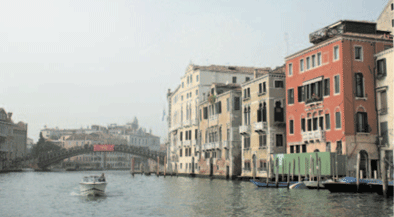 Venetia’s Channel. In this town, New Orleans and other towns in the Low Countries, the sea level rise risk seriously life if this problem is not faced accurately.
Venetia’s Channel. In this town, New Orleans and other towns in the Low Countries, the sea level rise risk seriously life if this problem is not faced accurately.
The first coastal areas to be damaged will be marshes and deltas, most of them being flooded mainly in the Cantabrian coast where the effects of incident waves are foreseen to increase on the coast.
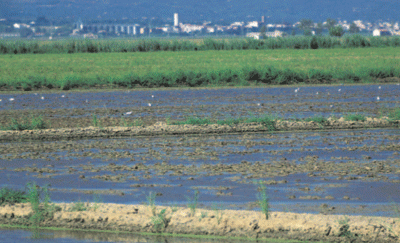
The most significant elements influencing on the sea level are the ocean’s thermal expansion (increasing volume due to water temperature and salinity), glacier retreating and the continental surface and deep water volume. Perhaps one of the main effects is water dilatation. The ocean’s level varies according to water density and, therefore, temperature and degree of salinity. This effect is due to melting ice since ice provides the system with freshwater that reduces its salinity. Recent information reveals that the ocean has been expanded 2-7cm over the last 100 years
Ice is the planet’s biggest freshwater reservoir. As a consequence of global warming, Antarctica’s and Greenland’s glaciers and ice sheets are constantly retreating, either due to direct ice melting or to blocks loosening in the form of icebergs, which becomes a risk to navigation. At this moment if all the ice piled up on the continents melted, the sea level would rise about 50cm. It is believed that from 1890 glaciers’ water has increased the sea level by about 0.5mm as average.
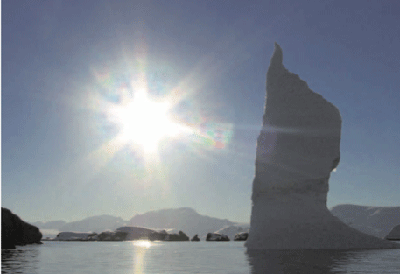
Finally, variations in the freshwater volume have also an impact on the sea level. In this case, the human action plays a key role, since the overexploitation of water reservoirs, such as dams, lakes, aquifers, either for consumption or for agricultural uses, has an effect on the water flowing into the sea.
Coral reefs are coastal ecosystems that play a key role in preserving the low coasts along the Pacific Ocean against sea erosion. Even though, they are so highly exposed to the sea level rise that these ecosystems are believed to disappear in the near future according to the most pessimistic predictions.
